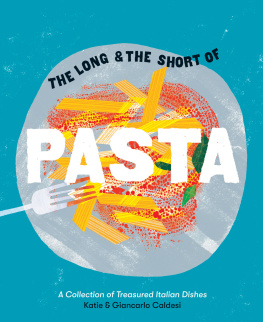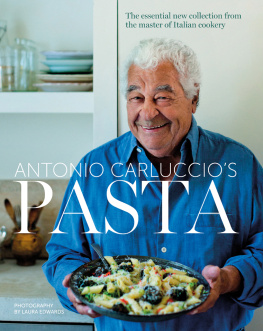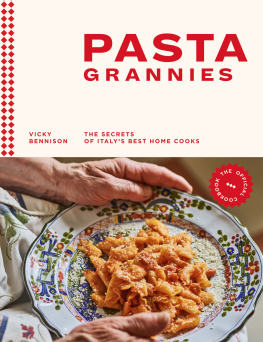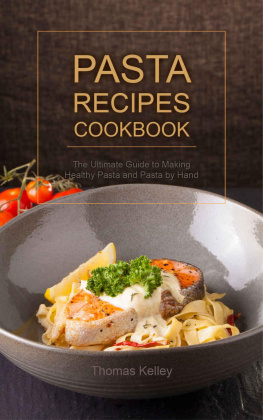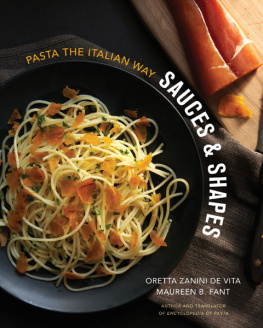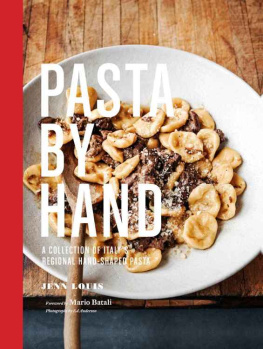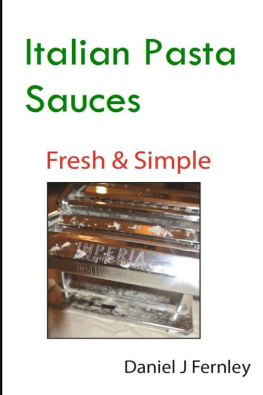Acknowledgments
It is true, as writer Laurie Colwin noted, that you never cook alone, that you cook with generations of cooks past, the advice and menus of cooks present, the wisdom of cookbook writers. I felt this strongly and gratefully while working on this book, that I was cooking alongside the generations of women and men whose hands have shaped this immense edible patrimony.
Most strongly, when I was cooking and learning alongside the inimitable Carla Tomasi, Rina Poletti and Alessandro Venturi. Also Alice Carosi-Adams, Fabrizia Lanza, Enza Di Gangi and Giovanna Di Bella at the Anna Tasca Lanza cooking school; Francesca Fughelli and her family in Bologna; Andrea, Tomasi and Angela at Pastificio Passi; Raffaella Cova in Tuscany; Giada Ferrara and family at Ristorante Sakalleo in Scoglitti; Rosalba Pelusi; Liborio DAleo; my mother-in-law, Carmela DAleo, Julia and Pino Ficara at the Grano & Farina cooking school; Daniela Del Balzo, Agusto and Andrea DAlfonsi at Ristorante La Torricella; Maria Paola Sacco; Matteo Pezzana at Il Pesto di Pra in Liguria. Huge thanks to the pasta makers, Massimo Mancini, Lorenzo Settimi, Paolo Mucci and Claudio Marcantoni at Pastificio Mancini in Le Marche, Sergio Cinque and everyone at Pastificio Faella in Gragnano.
Research and writing about pasta is no different from cooking it: it can be done thanks to the historians and scholars, past and present, who have synthesized the immense history. I wrote in the company of Giuseppe Prezzolini, Emilio Sereni, Silvano Serventi and Franoise Sabban, Oretta Zanini De Vita and her extraordinary Encyclopaedia of Pasta , Massimo Montanari. I am constantly grateful for the work and advice of Mary Taylor Simeti, Gillian Riley, Jill Norman, Simon Hopkinson, Anna Del Conte and Rosetta Costantino.
I am so happy this book found a home at Penguin with publisher Juliet Annan, whose appetite for the project propelled me. It was a joyful privilege to work with photographer Jonathan Lovekin. I have relished collaborating with everyone at Penguin, especially copy editor Annie Lee, designer Saffron Stocker, managing editor Natalie Wall and production manager Charlotte Faber. Also my friend Alice Carosi-Adams, who cooked with me for the photographs. Thanks to Linda Thompson for her diligent recipe testing, Rachel Rennie and Vincenzo for their eagle eyes on the Italian, and my parents, Jenifer and Martin Roddy, for reading and listening.
Thanks, too, to my agent Rosemary Scoular, and to Natalia Lucas, John Elek, Sophie Missing, and my colleagues at the Guardian Mina Holland, Bob Granleese, Anna Berrill, Tim Lusher, Fiona Beckett, Yotam Ottolenghi, Felicity Cloake, Grace Dent, Meera Sodha, Thomasina Miers, Anna Jones, Tamal Ray, Liam Charles, Tom Huntand to readers of my column. And thanks to my family, in England, Rome and Sicily, especially Luca and Vincenzo, who ate the whole book.
Also by Rachel Roddy
My Kitchen in Rome
Two Kitchens
a
Alfabeto
There are just 21 letters in the Italian alphabet, no J, K, W, X or Y. Less to remember, but frustrating if you are called Joy, because searching for your name is integral to eating a bowl of broth with letters.
There is no better way to begin this AZ than with alfabeto, tiny pasta in the shape of letters. Surely invented to engage children, and considered by some a gimmick, alfabeto is made of durum wheat and water. It is a pastina , part of a huge family of tiny shapes that includes puntini (dots), stelline (stars), tempestine (little storms), anelli (rings), fregula (balls) and quadrucci (little squares), some of which we will meet later in the alphabet. Unlike other small shapes that hold their own in soups, alfabeto really are tiny. Smaller than a currant or a crumb picked up with a damp finger, they stand up to nothing! And why should they, when they are best in a bowl of broth.
To write about alfabeto, or any pastina , is to write about Italian brodo , as the two are inseparable. Closer to consomm than stock, brodi are liquids to which meat or vegetables, or both, have given flavor, and of course come in cubes and granules too. Several pasta shapes are served in brodo, the most famous being belly-button meat-filled tortellini, which we will come to later. Whatever the form, the pasta is cooked directly in the brodo , and sometimes grated Parmesan is swirled in at the end, which clouds and enriches. While alfabeto suspended in brodo is something given to children, it is by no means just for children. It is a simple joy, although dont expect to find Joy in it.
Alfabeto in brodo
Serves 4
Bring 1 quart of vegetable or chicken broth (see ) to a boil, add 7 ounces (200g) of alfabeto and cook until al dente, which takes 47 minutes depending on the brand. Ladle into bowls, passing round grated Parmesan. Alfabeto can be substituted with any pastina . Spaghetti or dried tagliatelle snapped into short lengths are also lovely in broth.
Golden vegetable broth
Makes about 7 cups of broth
First up, I should note how much I like granules and cubes. But when I do make this vegetable broth, I am never not surprised at how good it is, the essence of vegetables and, as the name suggests, golden, thanks to the onion skins. To my mind all broths need salt added at the start in order to cook properly, but if you dont agree, add it at the end.
2 onions, unpeeled, halved
4 stalks of celery, quartered
3 carrots, peeled and quartered
1 small bulb of fennel, quartered
1 medium potato, peeled and halved
5 cherry tomatoes, halved
1 bay leaf
5 black peppercorns
3 cloves
salt
Put all the ingredients into a large heavy-bottomed stockpot and cover with 2 quarts of cold water.
Bring to a boil, then reduce the heat to low. Using a slotted spoon, skim off any froth or residue that has risen to the surface (dont worry too much about getting every bit), then cover the pot and simmer gently for 1 hours.
Strain through a fine sieve, pressing down on the vegetables to extract every bit of flavor. Taste and add more salt if you think it needs it.
A note about salt
There are two pots of salt by the stove. One of sale grosso, coarse, rubbly sea salt ideal for salting pasta water, in it a spoon that holds almost exactly 2 teaspoons (10 grams). The other pot is of sale fino, fine salt, also sea salt, for everything else. I am a great believer in adding little, often , that is, adding tiny, cautious pinches of salt throughout cooking, which is inextricably tied to the other cooking advice to live by, taste, taste, taste .
Brodo di pollo
Chicken broth
Makes 2 quarts of broth
Chicken broth, not too clear or strained of fat, is one of my great pleasures and soothers. This is my mother-in-laws recipe, although she removes the chicken skin. Again salt at the start is important, and the simmering must be calm and steady. The chicken will have given much by the end of cooking. But not allthe poached meat can, and should, be pulled from the bone and eaten with mustard or salsa verde or another herb pesto.





